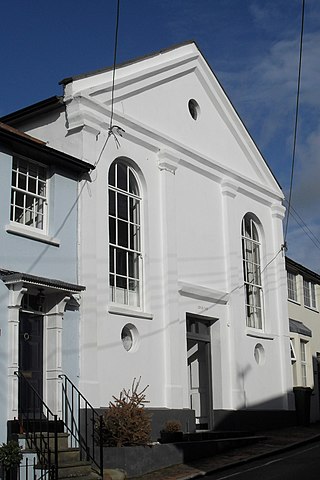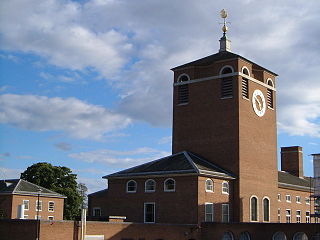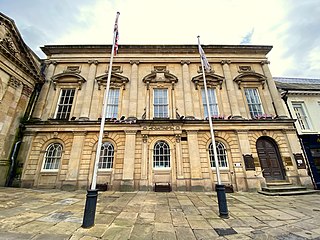
Arun is a local government district in West Sussex, England. Its council is based in Littlehampton. The district's other towns are Arundel and Bognor Regis. The district is named after the River Arun, which runs through the centre of the district. Parts of the district fall within the South Downs National Park.

West Sussex County Council is the upper tier local authority for the non-metropolitan county of West Sussex in England.

The Ancient Priors is a medieval timber-framed hall house on the High Street in Crawley, a town and borough in West Sussex, England. It was built in approximately 1450, partly replacing an older structure—although part of this survives behind the present street frontage. It has been expanded, altered and renovated many times since, and fell into such disrepair by the 1930s that demolition was considered. It has since been refurbished and is now a restaurant, although it has been put to various uses during its existence. Secret rooms, whose purpose has never been confirmed for certain, were discovered in the 19th century. English Heritage has listed the building at Grade II* for its architectural and historical importance, and it has been described as Crawley's "most prestigious medieval building" and "the finest timber-framed house between London and Brighton".

Jarvis Hall is a former Nonconformist chapel in the village of Steyning, in the Horsham district of the English county of West Sussex. Since its construction in 1835, the Classical-style building has been used by four different Nonconformist Christian denominations: the Countess of Huntingdon's Connexion, Wesleyan Methodists, the Salvation Army and Plymouth Brethren. The Brethren occupied it last and for the longest time. After about 150 years of religious use, it was sold for residential conversion. English Heritage has listed the former chapel at Grade II for its architectural and historical importance.

Madina Mosque is a mosque in the centre of Horsham, an ancient market town in the English county of West Sussex. It has served the Muslim community of the town and the surrounding district of Horsham since 2008. The plain stuccoed building in which it is housed was originally a Baptist chapel—one of several in the town, which has a long history of Nonconformist Christian worship. The former Jireh Independent Chapel was in commercial use until Muslims acquired it after a lengthy search for a permanent space. The organization, 'Muslims in Britain' classify the Madina Mosque as, "Deobandi".

Graylingwell Hospital was a psychiatric hospital in Chichester, West Sussex, United Kingdom.

Devon County Hall is a municipal building in Topsham Road, Exeter, Devon, England. The building, which is the headquarters of Devon County Council, is a Grade II* listed building.

Essex County Hall is a municipal building in Market Road, Chelmsford, Essex: it is the headquarters of Essex County Council. Blocks C and D are Grade II listed buildings.

Pelham House is a large red-bricked building at St Andrews Lane in Lewes, East Sussex. The building which was the headquarters of East Sussex County Council from 1938 to 1968, is a Grade II listed building.

County Buildings is a municipal facility at Martin Street in Stafford, Staffordshire. The building, which is the meeting place for both Staffordshire County Council and Stafford Borough Council, is a Grade II* listed building.

County Hall, formerly the Old Sessions House, is a municipal building in Sandling Road in Maidstone, Kent, England. The county hall, which is the headquarters of Kent County Council, is a Grade II listed building.

The County Offices is a municipal building in Newland, Lincoln in the county of Lincolnshire in England. It is the headquarters of Lincolnshire County Council.

The County Hall is a municipal facility on George Row in Northampton, Northamptonshire, England, which was the headquarters of Northamptonshire County Council until it was dissolved in 2021. It is a Grade II* listed building. The building is adjacent to the former Sessions House which is now used as a Tourist Information Centre.

Edes House is mansion in Chichester, West Sussex. The building, which was the headquarters of West Sussex County Council from 1916 to 1936, is a Grade I listed building.

Horsham Town Hall is a municipal building in the Market Square in Horsham, West Sussex. It is a Grade II listed building.

The Council House is a municipal building in North Street, Chichester, West Sussex, England. It is a Grade II* listed building.

Worthing Town Hall, or New Town Hall, is a municipal building in Chapel Road, Worthing, West Sussex, England. The town hall, which is a meeting place of Worthing Borough Council, is a Grade II listed building. Located at Chapel Road in the centre of Worthing, it was opened in 1933 and built in a neo-Georgian style to designs by Charles Cowles-Voysey. Containing offices and a Council chamber it replaced Worthing's Old Town Hall as the administrative centre, a building that had been the home of Worthing's local authority from 1835 and was demolished in 1966. To the rear and west lies the Assembly Hall, built in 1935, also to designs by Cowles-Voysey. To the south lies the Worthing Museum and Art Gallery, originally built as a Carnegie Library.

The Old Town Hall, is a former municipal building in Albion Street in Southwick, West Sussex, England. The building, which is now used as offices, was the meeting place of Southwick Urban District Council.

Horsham Friends Meeting House is a Religious Society of Friends (Quaker) place of worship in the town of Horsham, part of the district of the same name in West Sussex, England. It was built in 1786 to replace a meeting house nearly 100 years older on the same site, built for a Quaker community which had been active in the town for several years. "A fine Georgian building with original furnishings", it has Grade II listed status.




















